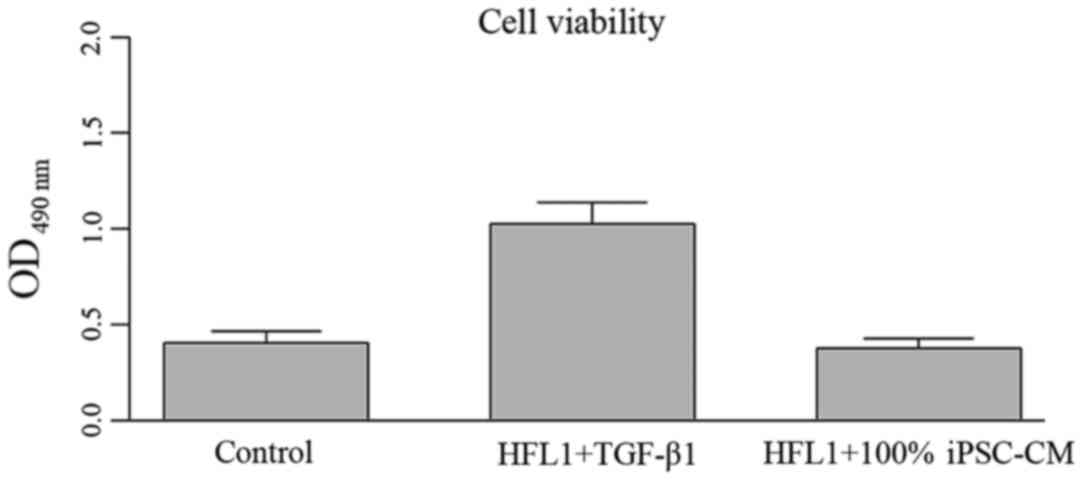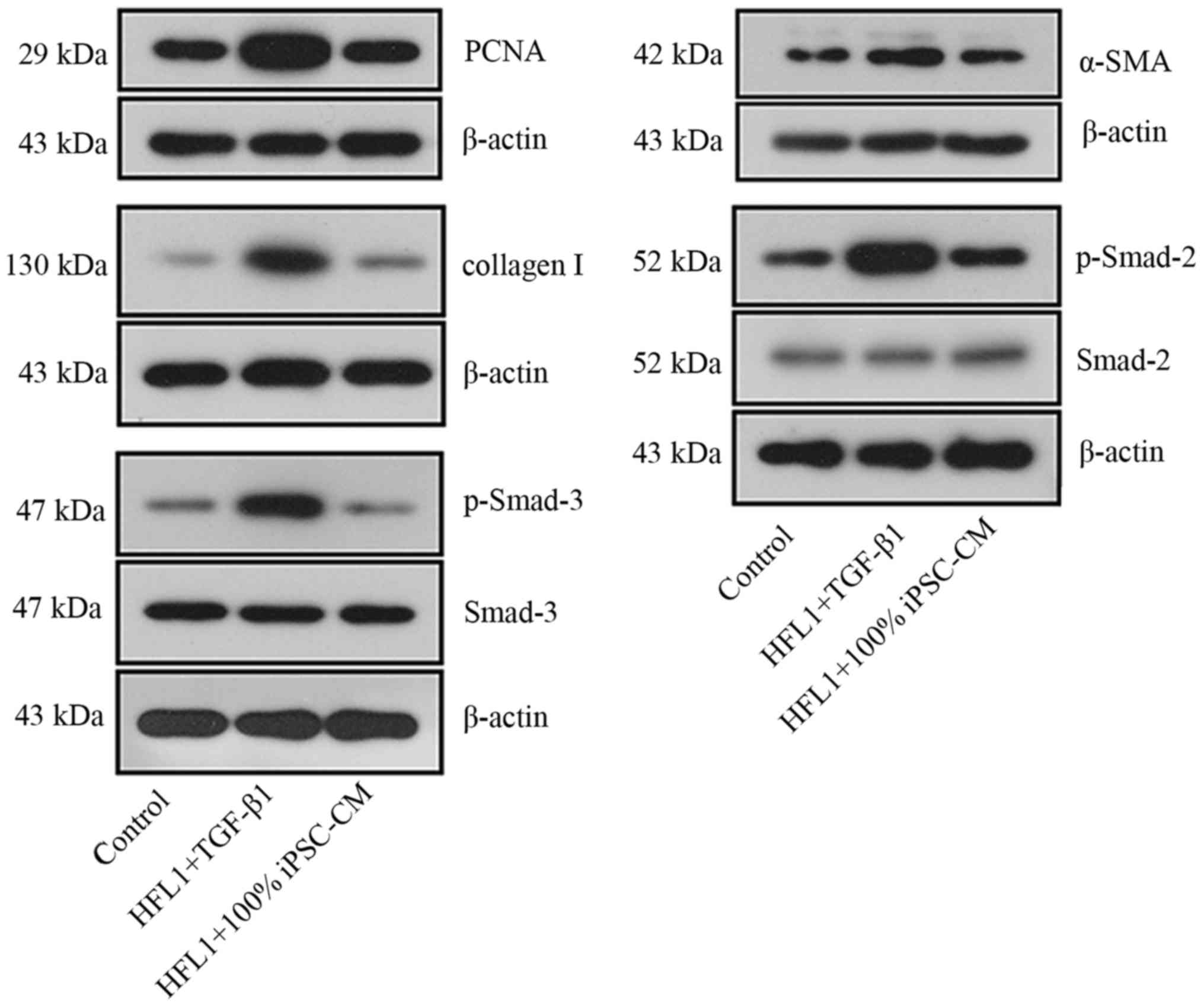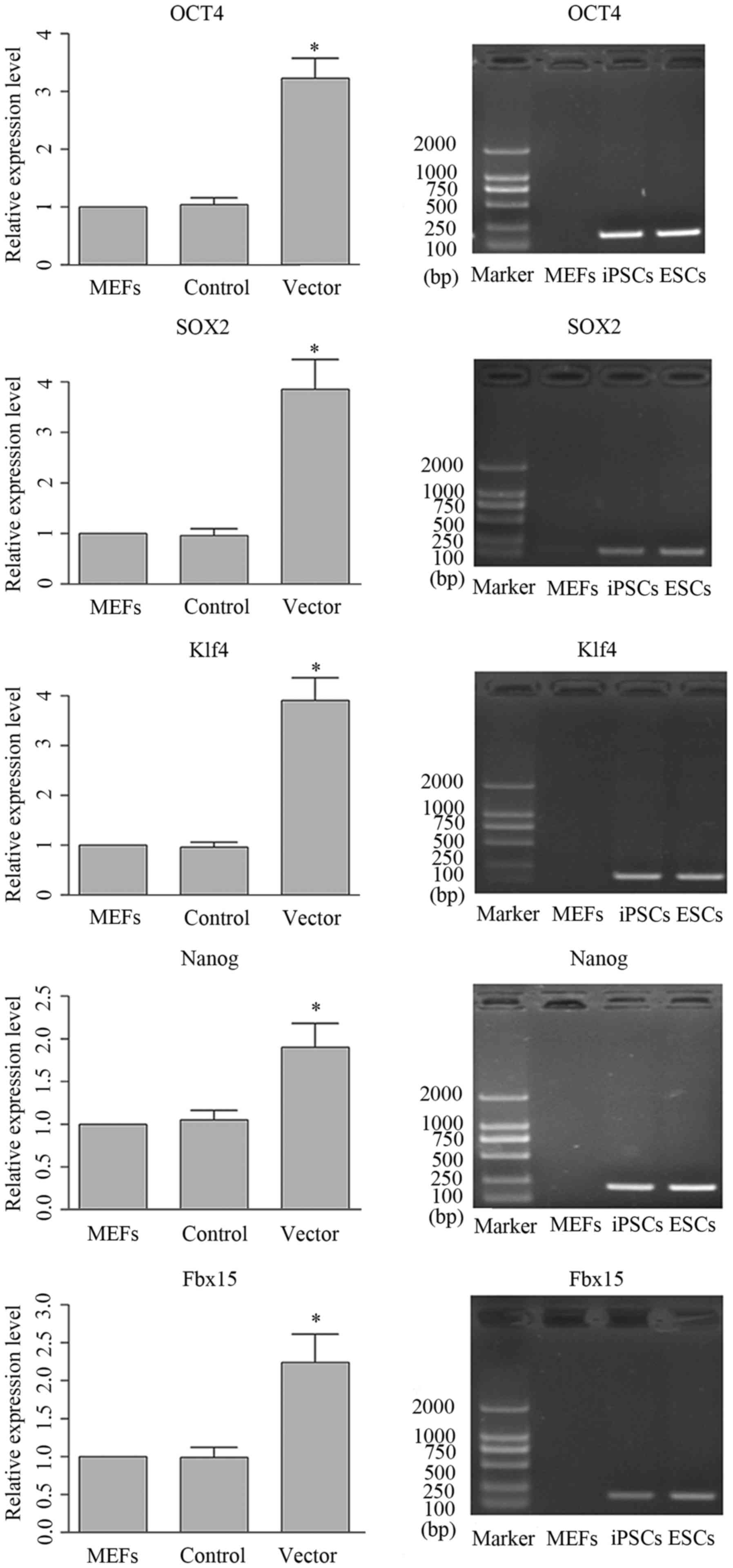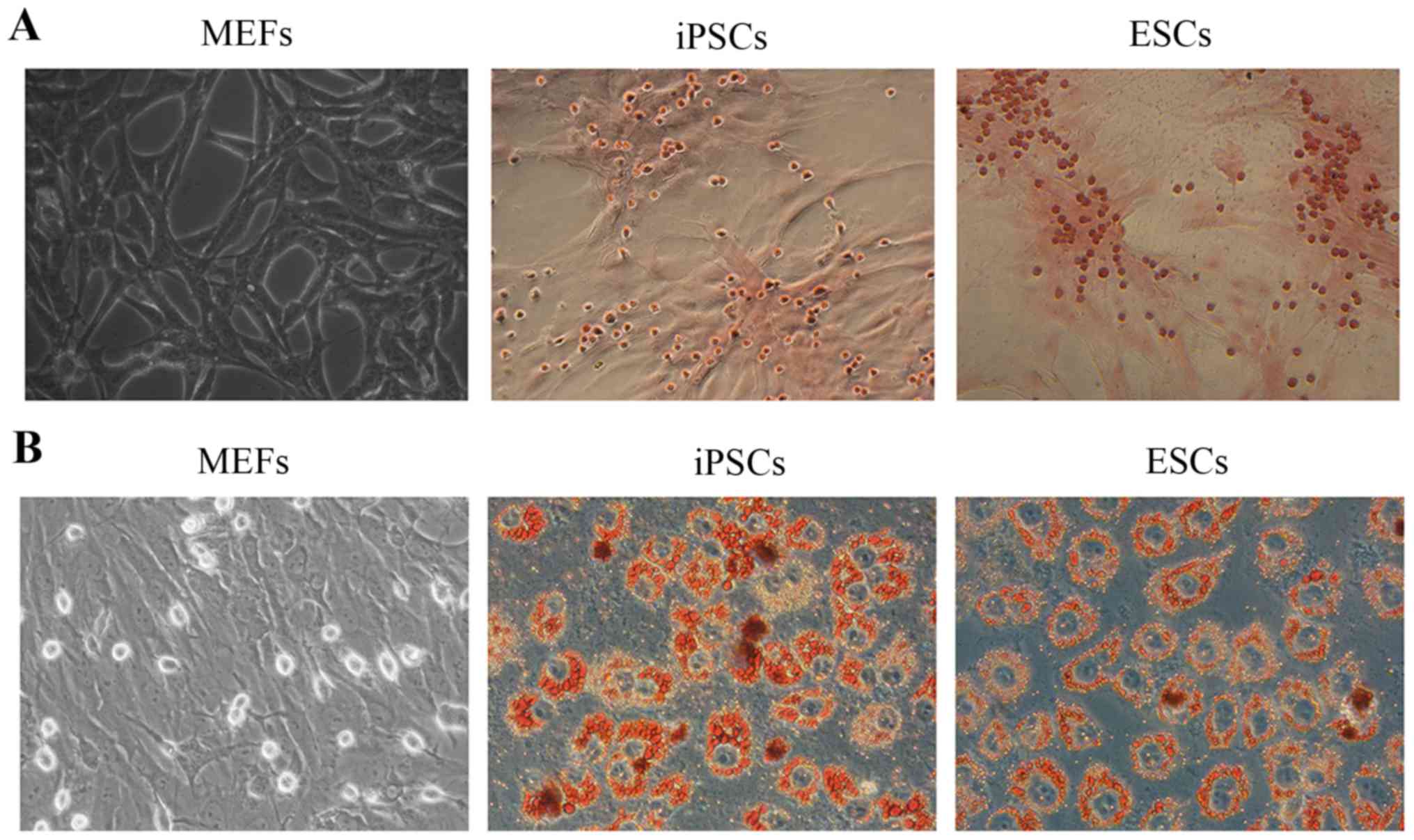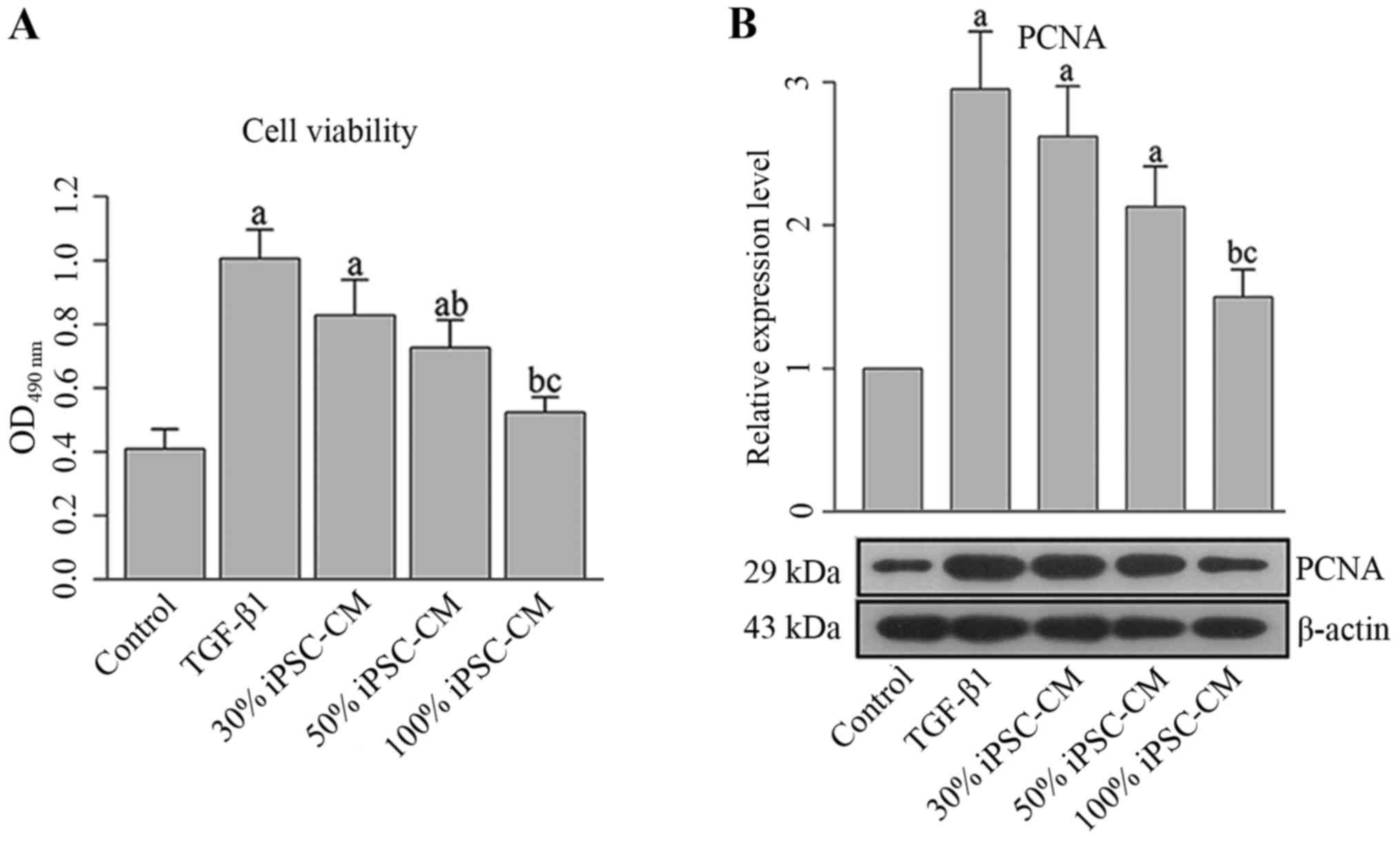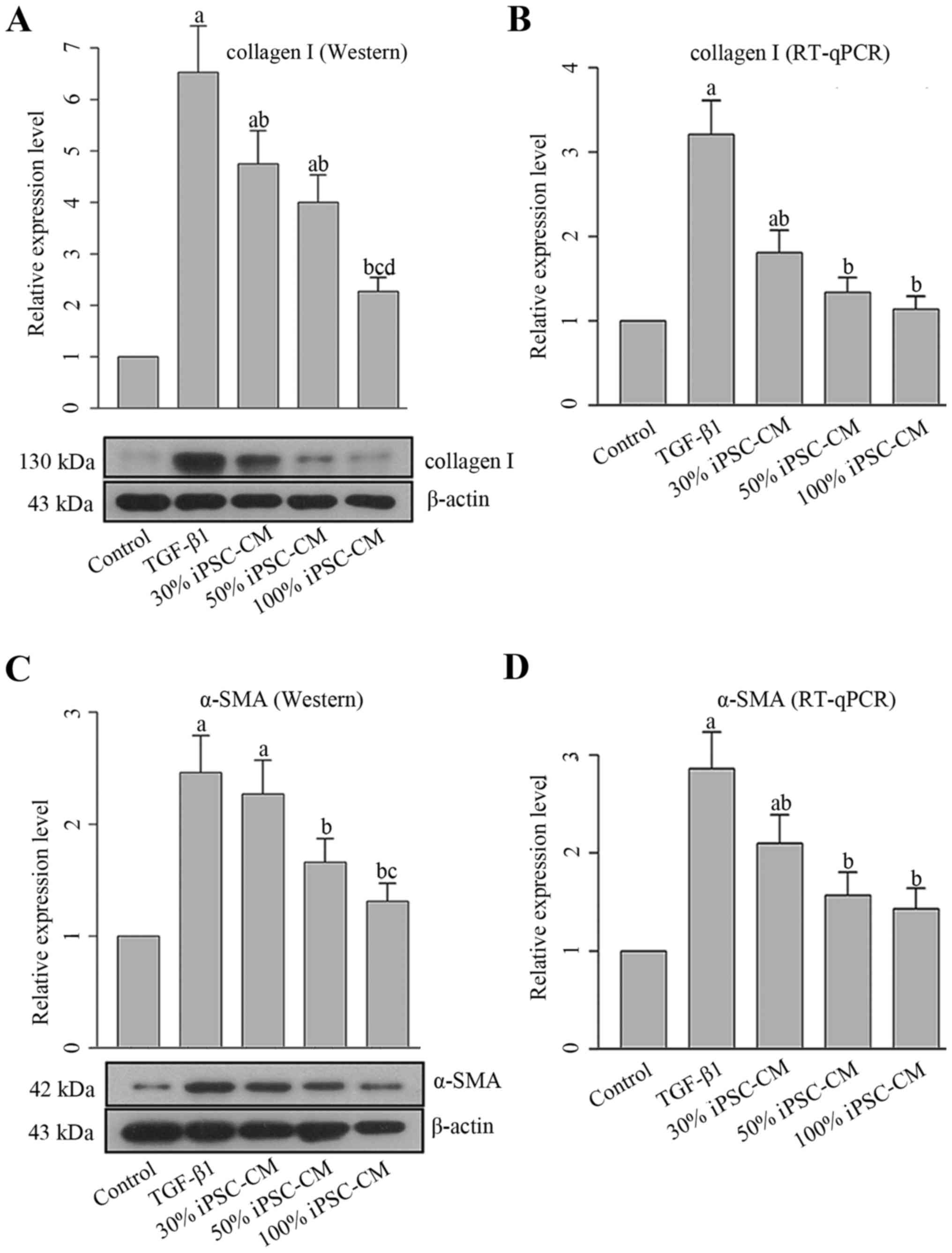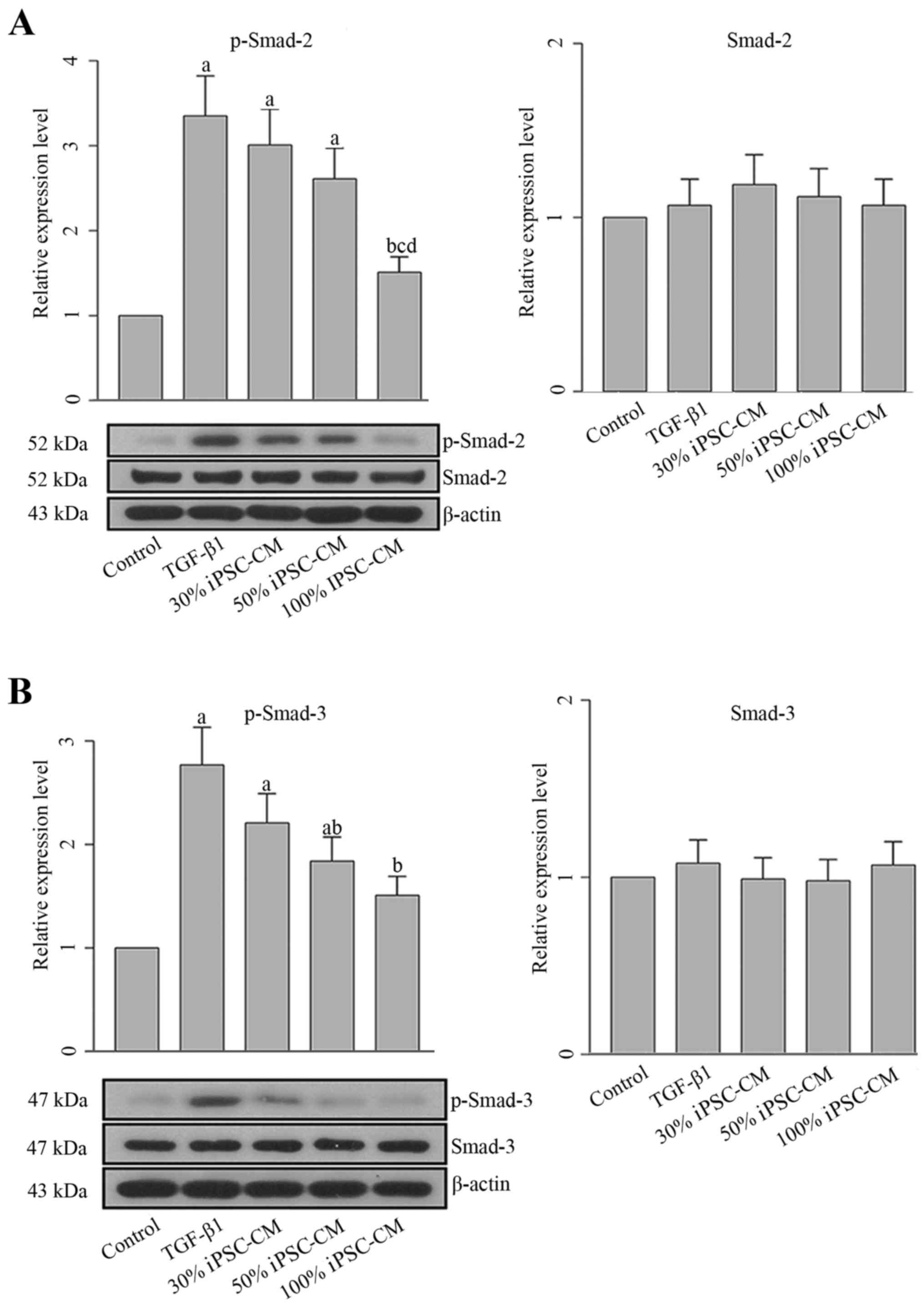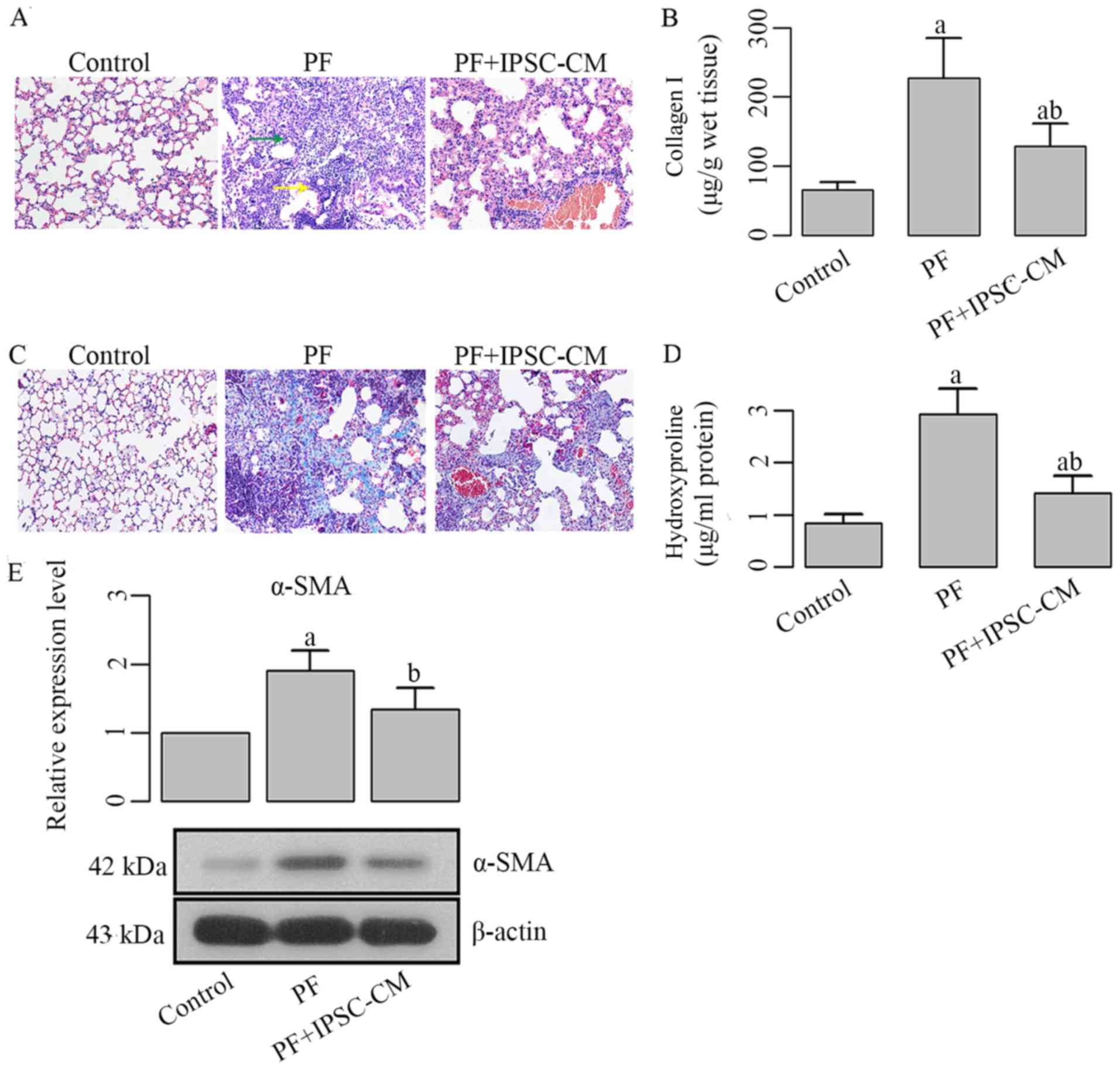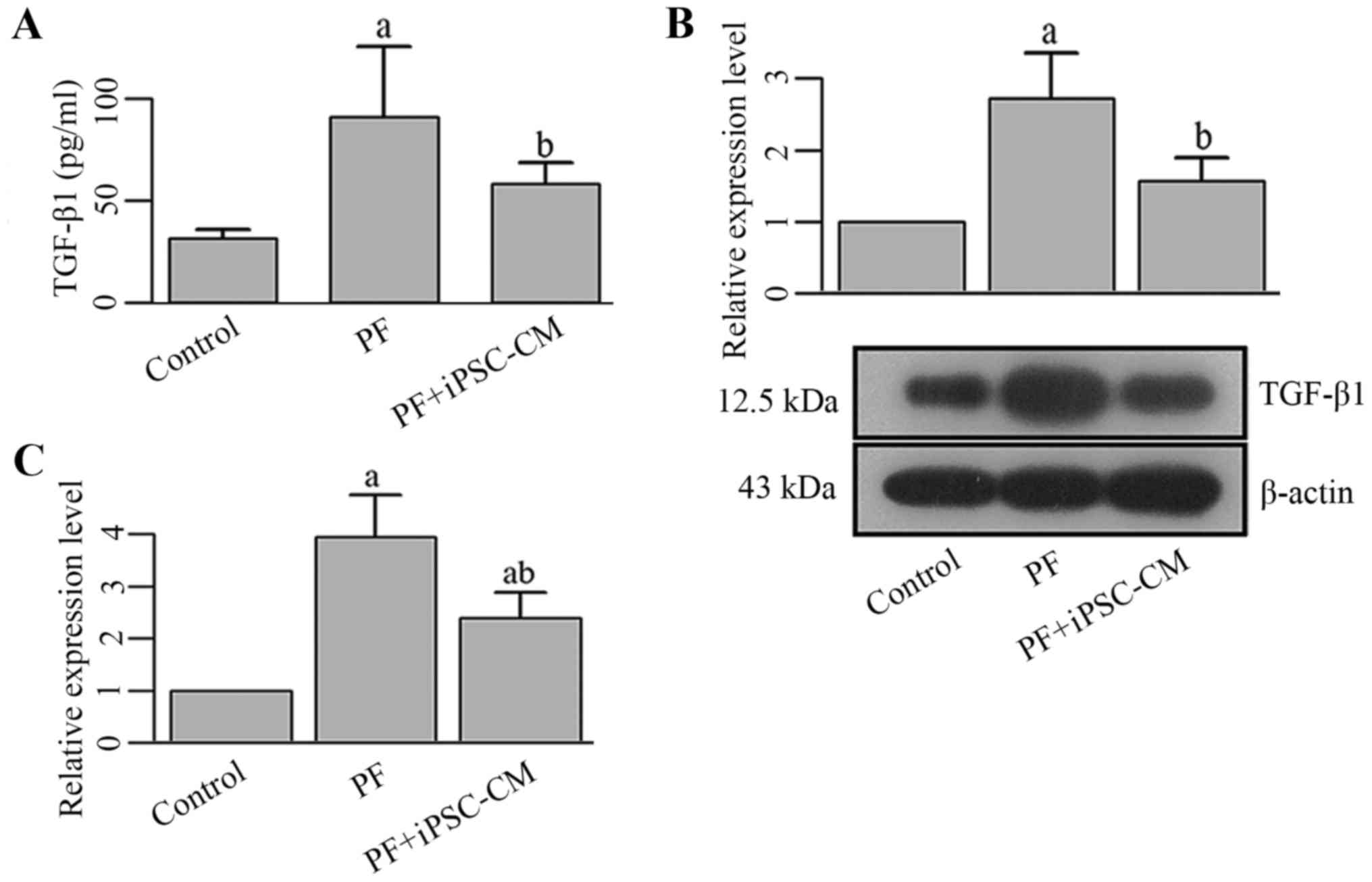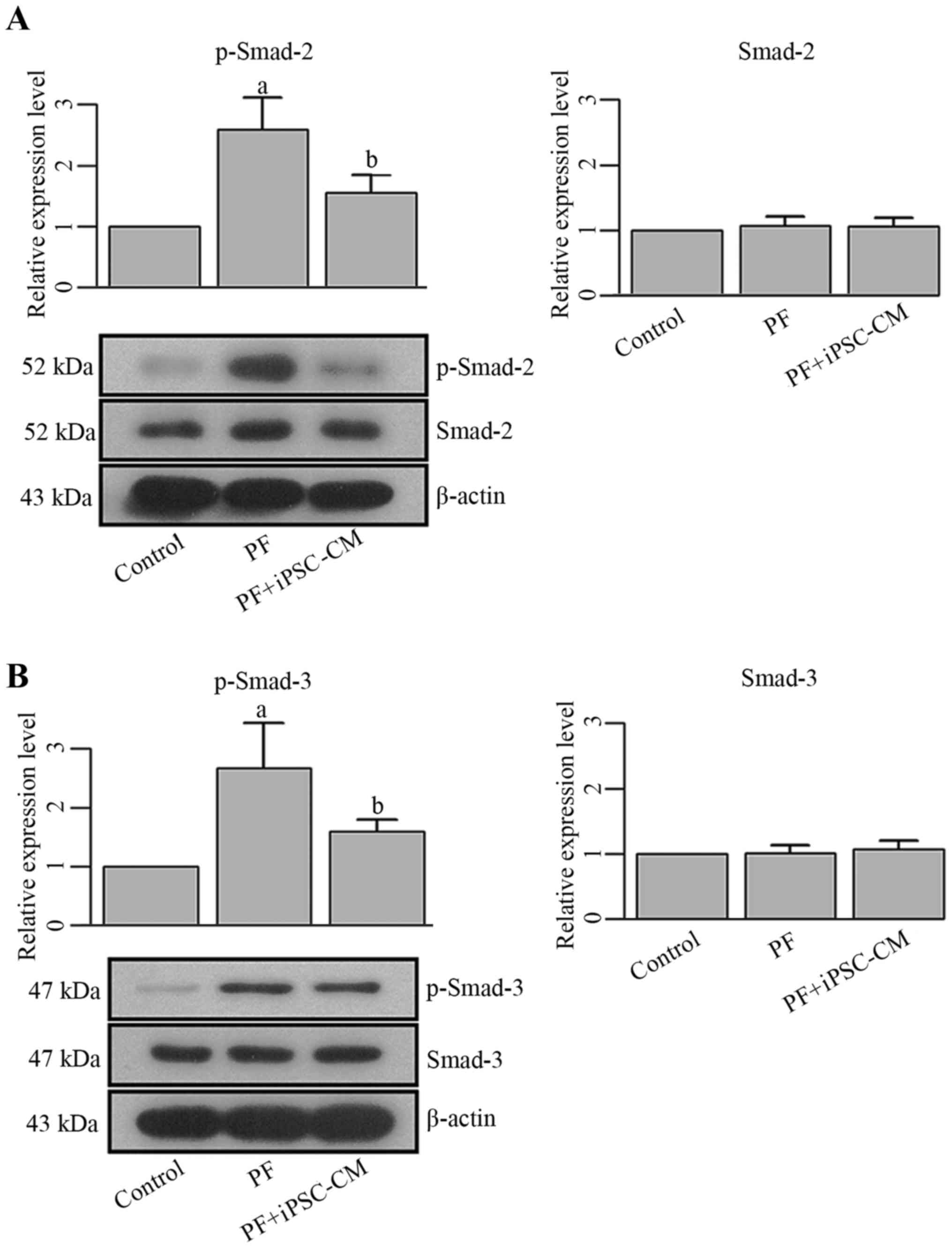Induced pluripotent stem cell-conditioned medium suppresses pulmonary fibroblast-to-myofibroblast differentiation via the inhibition of TGF-β1/Smad pathway
- Authors:
- Published online on: October 19, 2017 https://doi.org/10.3892/ijmm.2017.3199
- Pages: 473-484
-
Copyright: © Zhou et al. This is an open access article distributed under the terms of Creative Commons Attribution License.
Abstract
Introduction
Pulmonary fibrosis (PF) is a specific form of chronic fibrosing interstitial pneumonia limited to the lungs, which is characterized by disordered lung function (1,2). The etiology of PF is so complex that no accordance has been achieved. Of the diverse etiologies of PF, there is a common characteristic, i.e., the irregular deposition of extracellular matrix (ECM) that plays a key role in maintaining the normal lung tissue structure (3). One of the major sources of ECM are myofibroblasts, which have been identified as the intermediate between bone smooth muscle cells and fibroblasts, and are characterized by the expression of α-smooth muscle actin (α-SMA). Previous studies have proven that the differentiation of fibroblasts into myofibroblasts is modulated by transforming growth factor-β1 (TGF-β1). The molecule is capable of regulating the expression of α-SMA in fibroblasts as well (4,5). Based on these overwhelming findings, TGF-β1 has already been regarded as a potential target for the amelioration of PF. Current treatments of PF involving the targeting of TGF-β1 are based on neutralizing antibodies, antisense TGF-β1 oligo deoxynucleotides and specific inhibitors to TβR kinases. However, TGF-β1 plays important roles in regulating inflammation and acts as a tumor suppressor in some contexts; thus, arbitrarily reducing the systemic level of this cytokine may have some unexpected side-effects. The development of novel but non-invasive schemes regulating TGF-β1 is therefore critical for the improvement of the outcome and survival of patients with PF.
Recent evidence that embryonic stem cells (ESCs) or adult stem cells are capable of repairing and regenerating the injured or diseased tissues (6) has inspired extensive investigation of the stem cell-based therapies in treating devastating and incurable lung diseases. Considering ethical or safety issues associated with the application of ESCs, most studies focused on stem cell therapies are performed based on adult stem cells, such as induced pluripotent stem cells (iPSCs) (7). iPSC is a multi-lineage differentiation cell population which can be conveniently induced from certain cell lines through reprograming by specifically transcription factor transduction (8,9), and can provide a resource for stem cell-based therapies. Treatments of endotoxin-induced acute lung injury using iPSCs have already achieved considerable outcomes; the therapy stimulates the production of paracrine mediators and regulates neutrophil activities in response to endotoxins and the inflammatory response (8,10). Moreover, these reports have also proven the low tumorigenic risk of the use of iPSCs scheme as an advantage over antibody-based therapies (8,9). However, it remains unclear as to whether iPSC-based treatment has the capability to regulate the dysexpression of TGF-β1, inhibit the differentiation of fibroblasts into myofibroblasts and attenuate the damage due to PF.
Thus, in the present study, we attempted to evaluate the protective effects of iPSC-conditioned medium (iPSC-CM) against PF through the TGF-β1-related pathway in a mouse model of bleomycin-induced PF. The effects of iPSC-CM on pulmonary morphology were determined by hematoxylin and eosin (H&E) staining and Masson's staining. The regulatory function of iPSC-CM on TGF-β1 and other molecules related to PF was evaluated using enzyme-linked immunosorbent assay (ELISA), reverse transcription-quantitative PCR (RT-qPCR) and western blot analysis.
Materials and methods
Chemicals, animals and cell culture
Antibodies against proliferating cell nuclear antigen [proliferating cell nuclear antigen (PCNA); cat. no. bs-2006R), p-Smad-2 (cat. no. bs-5618R), Smad-2 (cat. no. bs-0718R), p-Smad-3 (cat. no. bs-5459R) and Smad-3 (cat. no. bs-3484R) were all purchased from Bioss, Inc. (Woburn, MA, USA). Antibodies against α-smooth muscle actin (α-SMA; cat. no. BM0002) and collagen I (cat. no. BA0325), were purchased from Wuhan Boster Biological Technology, Ltd. (Wuhan, China). Antibody against β-actin (cat. no. sc-47778) was purchased from Santa Cruz Biotechnology, Inc. (Santa Cruz, CA, USA). Male C57BL/6 mice (8–10 weeks old; weighing 24 to 45 g) were purchased from the Experimental Animal Center of China Medical University. All the animals were maintained at 20–25°C with a constant humidity of 55±5% with free access to food and water. All animal experiments were conducted in accordance with the Institutional Animal Ethics Committee and Animal Care Guidelines of Shengjing Hospital of China Medical University which governed the use of the animals. Previously preserved human lung fibroblasts (HFL1 cell line; cat. no. GNHu28; Cell Bank of Chinese Academy of Sciences, Shanghai, China) were cultured in dulbecco's modified Eagle's medium (DMEM/F-12) medium [10% (v/v) fetal bovine serum (FBS) and 1% (v/v) antibiotics mixture] in 95% air and 5% CO2 at 37°C.
Generation of iPSCs by mouse 3-gene transfection, identification and cell culture
Mouse 3-gene iPSCs were established via the transfection of Oct4/Sox2/Klf4 into C57BL/6 mice as previously described (7,11). Mouse embryonic fibroblasts (MEFs) were isolated from the placentas of 10 C57 pregnant mice (10 weeks old, at 2 weeks of gestation, purchased from Charles River Lab, Beijing, China). Briefly, the placentas were washed with PBS twice. The outer membrane of the placenta was removed carefully with ophthalmic scissors and the left tissues were washed with PBS again and cut into 1–3 mm3 sections. The tissues were incubated in FBS in an atmosphere consisting of 5% CO2 and 95% air at 37°C for 12 h and transferred to DMEM (supplemented with 10% FBS) and cultured for 5 days. The cells were then transferred to wells of a 12-well plate and cultured for a further 10–15 days. Afterwards, the supernatant of the cultures was discarded and the cells were incubated with 0.25% pancreatin until the cells turned into spheroidal shape. The cells were then collected by centrifuging at 1,000 rpm for 5 min and preserved at 37°C for subsequent assays. ESCs (cat. no. SCSP-226) were purchased from the Cell Bank of Chinese Academy of Sciences. Briefly, the MEFs were incubated in one well of the 6-well plates at a density of 8×105/well one day prior to transfection with lentivirus vectors encoding Oct4/Sox2/Klf4 mouse complementary DNA. For transfection, equal amounts of the supernatants containing each of the three vectors were mixed and transferred to the MEF dishes and incubated overnight. The cells were then replated in fresh medium and incubated overnight before the medium was replaced with DMEM supplemented with 10% FBS. At 48 h after transfection, positive colonies were selected using DMEM supplemented with 15% FBS, 2 mM L-glutamine, 1×10−4 M non-essential amino acid and 1×10−4 M M2-mercaptoethanol. The total RNA in undifferentiated iPSCs, MEFs and ESCs were extracted using the RNA simple total RNA kit according to the manufacturer's instructions (no. DP419; Tiangen, Beijing, China) for RT-qPCR validation as described below. Thereafter, the osteogenic differentiation and adipogenic differentiation potential of the iPSCs, MEF and ESCs were detected using the Alizarin Red S and Oil Red O staining methods, respectively as previously described (12). Following the identification of the iPSCs, the undifferentiated iPSCs were routinely cultured at 37°C in an atmosphere of 95% air and 5% CO2.
Osteogenic and adipogenic induction
Osteogenic induction was performed by incubating the cells in medium consisting of DMEM/F12 (cat. no. SH30023.01B; HyClone, Logan, UT, USA) supplemented with 10% FBS (cat. no. SH30084.03; HyClone), 0.25 mmol/l ASA (cat. no. A8960-5G; Sigma-Aldrich, St. Louis, MO, USA), 10 mmol/l β-glycerolphosphate (cat. no. 201205053; Biosharp, St. Louis, MO, USA), and 10−7 mol/l dexamethasone (cat. no. D1756; Sigma-Aldrich).
Adipogenic induction was performed by incubating the cells in medium consisting of DMEM/F12 (cat. no. SH30023.01B; HyClone) supplemented with 10−7 mol/l dexamethasone (cat. no. D1756; Sigma-Aldrich), 100 nmol/l insulin (Fosun Pharma, Shanghai, China), 0.2 mmol/l indomethacin (cat. no. 17378-5G), and 5% FBS (cat. no. SH30084.03; HyClone).
Detection of osteogenic and adipogenic potential
For Alizarin Red staining, the cells were fixed with 4% paraformaldehyde for 15 min and stained with 0.1% Alizarin Red (cat. no. A5533-25G; Sigma-Aldrich) for 40 min at room temperature. The results were detected under a microscope at ×400 magnification. For Oil Red O staining, cells were fixed with 4% paraformaldehyde for 30 min and stained with 0.6% Oil Red O (cat. no. O0625-25G; Sigma-Aldrich) for 1 h at room temperature. The results were detected under a microscope at ×400 magnification.
Preparation of the iPSC-CM
The iPSCs were culture routinely for 24 h before being transferred to serum-free DMEM [containing 2 mM L-glutamine (cat. no. 59202C) and 1×10−4 M non-essential amino acid (cat. no. H7145) (both from Sigma-Aldrich), 1×10−4 M M2-mercapto ethanol (cat. no. 21985-023; Gibio)] and cultured for a further 48 h. The supernatants (supernatant 1) of the iPSC medium were collected and centrifuged for 10 min at 1,500 rpm to separate the supernatants (supernatant 2) from precipitation. For subsequent experiments, the supernatant was employed as iPSC-CM.
Treatment of HFL1 cells with iPSC-CM and TGF-β1
To evaluate the inhibitory effect of iPSC-CM on the proliferation of fibroblasts, HLF1 cells were treated with various combinations of iPSC-CM and TGF-β1 as follows: i) the control group, normal HFL1 cells; ii) the TGF-β1 group, HFL1 cells incubated with TGF-β1 (5 ng/ml) for 24 h to induce differentiation into myofibroblasts; iii) the 30% iPSC-CM group, HFL1 cells incubated with 30% iPSC-CM and TGF-β1 (5 ng/ml) for 24 h; iv) the 50% iPSC-CM group, HLF1 cells incubated with 50% iPSC-CM and TGF-β1 (5 ng/ml) for 24 h; v) the 100% iPSC-CM group, HLF1 cells incubated with 100% iPSC-CM and TGF-β1 (5 ng/ml) for 24 h. Each treatment was represented by at least 3 replicates. Moreover, the cytotoxicity of iPSC-CM was assessed and no impairment on the cell normal biological processes was detected (Figs. 1 and 2).
3-(4,5-Dimethylthiazol-2-yl)-2,5-diphenyltetrazolium bromide (MTT) assay
Upon completion of the 24 h of incubation, MTT assay was performed to determine the viability of the HLF1 cells in the different groups. Briefly, 50 μl exponentially growing cells (2×105 cells/ml) were seeded into a 96-well plate in triplicate. Subsequently, 5 mg/ml MTT were added to each well followed by incubation for 4 h at 37°C. The optical density (OD) values in different wells were recorded using a mircoplate reader (ELX-800; BioTek Instruments, Inc., Winooski, VT, USA) at 490 nm. The survival rates (%) of the different treatment groups were calculated as follows: (OD value in treatment group - OD value in blank control group)/(OD value in negative control group - OD value in blank control group) ×100%.
RT-qPCR
The RNA samples were reverse transcribed into cDNA using Super M-MLV reverse transcriptase (no. RP6502; Bioteke, Beijing, China), and the final reaction mixture of volume 20 μl contained 10 μl of SYBR-Green Mastermix, 0.5 μl of each of the following primers: Nanog forward, 5′-CAGGGCTATCTGGTGAACG-3′ and reverse, 5′-CGAA GTTATGGAGCGGAGC-3′; octamer-binding transcription factor 4 (OCT4) forward, 5′-CCCAACGAGAAGAGTATGAGG-3′ and reverse, 5′-GAGCAGTGACGGGAACAGA-3′; SOX2 forward, 5′-GCACAGATGCAACCGATGC-3′ and reverse, 5′-TCGGACTTGACCACAGAGCC-3′; Kruppel-like factor 4 (Klf4) forward, 5′-CCTACTTATCTGCCTTGCTGATTGTC-3′ and reverse, 5′-CCCCCAGATTGCCCGAGAT-3′; Fbxo15 (Fbx15) forward, 5′-GGGATAAAGAAGATGGATACTGG-3′ and reverse, 5′-GATTGTCCAACCTAAGCCAGA-3′; TGF-β1 forward, 5′-GCAACAATTCCTGGCGTTACCT-3′ and reverse, 5′-GAAAGCCCTGTATTCCGTCTCC-3′; α-SMA forward, 5′-TCCCTTGAGAAGAGTTACGAGTT-3′ and reverse, 5′-ATGATGCTGTTGTAGGTGGTT-3′; collagen I forward, 5′-AGGTGTTGTGCGATGACGTGAT-3′ and reverse, 5′-TGGTTTCTTGGTCGGTGGGTGA-3′; murine β-actin forward, 5′-CTGTGCCCATCTACGAGGGCTAT-3′ and reverse, 5′-TTTGATGTCACGCACGATTTCC-3′; Homo sapiens β-actin forward, 5′-CTTAGTTGCGTTACACCCTTTCTTG-3′ and reverse, 5′-CTGTCACCTTCACCGTTCCAGTTT-3′, 1 μl of the cDNA template, and 8 μl ddH2O. Thermal cycling parameters for the amplification were as follows: a denaturation step at 95°C for 10 min, followed by 40 cycles at 95°C for 10 sec, 60°C for 20 sec and 72°C for 30 sec. Relative gene expression was evaluated with Exicyler™ 96 (Bioneer, Daejeon, Korea). The relative expression levels of different genets were determined according to the 2−ΔΔCt method.
Western blot analysis
Total proteins from the different groups were extracted using the total protein extraction kit according to the manufacturer's instructions (cat. no. WLA019; Wanleibio, Shenyang, China) and the concentration of each sample was determined using the BCA kit (cat. no. WLA004, Wanleibio). β-actin was used as internal reference protein. All the extracts were boiled in loading buffer for 5 min and 20 μg of protein was subject to a 10% sodium dodecyl sulfate-polyacrylamide gel electrophoresis (SDS-PAGE). Targeted proteins were then transferred onto polyvinylidene difluoride (PVDF) membranes. The membranes were washed with TBST for 5 min and then transferred into blocking buffer for overnight incubation at 4°C. Following 3 cycles of 5 min washes with TBST, primary antibodies against different proteins [PCNA (1:500), α-SMA (1:400), collagen I (1:400), p-Smad-2 (1:500), Smad-2 (1:500), p-Smad-3 (1:500), Smad-3 (1:500) and β-actin (1:1,000)] were incubated with the membranes for 1 h at room temperature. After an additional 3 washes, secondary IgG-HRP antibodies [1:5,000; goat anti-rabbit antibody (cat. no. WLA023; Wanleibio), goat anti-mouse IgG-HRP antibody (cat. no. A0216; Beyotime Biotechnology, Shanghai, China)] were added and incubated with the membranes for 40 min. Following a final 3 washes using TBST, the blots were developed using Beyo ECL Plus reagent and the results were detected in the gel imaging system. The relative expression levels of different proteins were calculated using Bio-Rad Quantity One software (Bio-Rad Laboratories, Inc., Hercules, CA, USA).
Detection of the effects of iPSC-CM on the TGF-β1 mediated differentiation of HFL cells into myofibroblasts
The HFL1 cells were treated as described above only with the incubation course changed to 48 h. The mRNA and protein expression levels of α-SMA and collagen I were determined using RT-qPCR and western blot analysis as described above.
Detection of the effects of iPSC-CM on the TGF-β1 signal transduction pathway in HFL1 cells
The HFL1 cells were primarily incubated with various percentages of iPSC-CM as mentioned above for 24 h and were then treated with 5 ng/ml TGF-β1 for a further 30 min. The expression of Smad-2, p-Smad-2, Smad-3 and p-Smad-3 was detected using western blot analysis.
Establishment of mouse models of PF
Male C57BL/6 mice were randomly divided into 3 groups (6 in each group) as follows: i) the control group: mice were intratracheally injected with normal saline under anesthesia via an intraperitoneal injection of 80 mg/kg pentobarbital sodium for 24 h; ii) the PF group: mice were intratracheally injected with 5 mg/kg bleomycin sulfate (Merck Millipore, darmstadt, Germany) under anesthesia for 24 h to induce PF before being intravenously injected with 200 μl normal saline; iii) the PF + iPSC-CM group: after induction of PF, mice in this group were intravenously injected with 200 μl iPSC-CM. At 21 days after the establishment of the model, the mice in different groups were sacrificed to collect bronchoalveolar lavage fluid (BALF) and lung tissues. The main bronchus of right lung of each mouse was ligated and a catheter was inserted into the right lung at the same time. The lung was washed with normal saline using a catheter 3 times (0.5 ml each time) and the BALF was collected. The mice were then sacrificed and the lungs were collected. The right lung was cut into sections and fixed with 4% paraformaldehyde, and the tissues of the left lung were preserved at −80°C.
H&E staining
Each lung tissue sample was fixed in 4% paraformaldehyde, dehydrated with a graded ethanol series, embedded in paraffin blocks, cut into 3-μm-thick sections, and stained with H&E following standard histologic techniques. The results of the staining were observed using a microscope (DP73; Olympus, Tokyo, Japan) at ×200 magnification.
Analysis of collagen accumulation
To assess the effects of iPSC-CM on collagen accumulation due to PF, Masson's trichrome staining [Aniline blue (cat. no. 229661000), Ponceau (cat. no. p8330) and acid fuchsin (cat. no. 71019360); Sinopharm Group, Beijing, China)] was utilized to demonstrate the changes in the tissue samples which were associated with the formation of collagen according to the method of Flint and Lyons (13). ELISA for collagen I was also conducted using an ELISA kit (StressXpress; Assay designs/Stressgen Bioreagents) according to the manufacturer's instructions. Moreover, the content of hydroxyproline was determined using a previously described method (13). The expression of α-SMA was determined by western blot analysis as described above.
Determination of the effects iPSC-CM on the TGF-β1 signal transduction pathway in C57BL/6 mice
The content of TGF-β1 in BALF was determined by ELISA. The expression of TGF-β1 in different lung tissue samples was quantified by RT-qPCR. The production of TGF-β1, Smad-2, p-Smad-2, Smad-3 and p-Smad-3 was assessed by western blot analysis.
Statistical analysis
All the data are expressed as the means ± SD. ANOVA and post hoc multiple comparisons were conducted using the LSD method with a general liner model with a significance level of 0.05. All the statistical analyses and graph manipulation were conducted using S R language version 3.2.1 (R Foundation for Statistical Computing).
Results
Generation of iPSCs using mouse 3-gene transfection
iPSCs were generated by MEFs using mouse 3-gene transfection method. Positive clones were selected and the expression patterns of the genes which were the signature of mouse ESCs were validated by RT-qPCR. The representative image and quantitative analysis of RT-qPCR are shown in Fig. 3. It was illustrated that following transfection, the expression levels of the target genes were all upregulated. The expression patterns in the iPSCs and ESCs were identical, and the differences between iPSCs and MEFs was statistically significant, which indicated the successful generation of IPSCs with the present method. Furthermore, the differentiation of the mouse 3-gene-transfected iPSCs towards the osteogenic and adipogenic lineages were detected using the Alizarin Red S and Oil Red O staining methods, respectively. As shown in Fig. 4A, the deposition of Alizarin Red could be detected in the iPSCs and ESCs, while the MEFs showed no reaction with Alizarin Red, representing the osteogenic differentiation potential of iPSCs which was identical to that of the ESCs. Similarly, in Oil Red O assays, the deposition of Oil Red O could only be detected in the iPSCs and ESCs (Fig. 4B). The above-mentioned resutls indicate the successful generation of iPSCs using the mouse 3-gene transfection method.
The administration of iPSC-CM inhibits the proliferation of HFL1 cells
The growth of HFL1 cells was directly assessed by MTT assay and indirectly determined using PCNA western blot analysis. As illustrated in Fig. 5A, proliferative ability of the HFL1 cells was enhanced following incubation with TGF-β1 for 24 h. Following treatment with iPSC-CM, the viability of the HFL1 cells was significantly inhibited. The differences between the TGF-β1 group and the 50% iPSC-CM or 100% iPSC-CM groups were statistically significant (P<0.05; Fig. 5A). Moreover, with the increasing iPSC-CM concentration, the inhibitory effect of the iPSC-CM was significantly enhanced, with the proliferation of the HLF1 cells in the 100% iPSC-CM group being comparable to that of the cells in the control group, representing a dose-dependent regulatory effect of iPSC-CM on the viability of HFL1 cells (Fig. 5A). A similar pattern with the prodcution of PCNA was also recorded by western blot analysis, confirming the inhibitory effect of iPSC-CM on the TGF-β1-induced proliferation of HLF1 cells (Fig. 5B).
iPSC-CM inhibits the TGF-β1-induced differentiation of HFL1 cells into myofibroblasts via the Smad-mediated signal transduction pathway
PF is characterized by the activation of collagen, and myofibroblasts are characterized by the expression of α-SMA. Therefore, the levels of collagen I and α-SMA were both determined at the mRNA and protein level. As shown in Fig. 6, incubation with TGF-β1 increased the expression levels of both molecules compared with the control HFL1 cells. Similar to the results of MTT assay and PCNA content, iPSC-CM reverse the effects induced by TGF-β1, which further resulted in the inhibition of the differentiation of HFL1 cells into myoblasts. These effects were also exerted in a dose-dependent manner.
To determine whether the effects of iPSC-CM on PF are exerted through the TGF-β1-mediated signal transduction pathway, the production and activation of Smad-2 and Smad-3 in HFL1 cells were also detected. The overexpression of p-Smad-2 and p-Smad-3 in the HLF1 cells was observed following incubation with TGF-β1 (Fig. 7). No significant changes were observed in the levels of total Smad-2 and Smad-3. The activation of Smad-2 and Smad-3 was associated with all collagen types, and these results confirmed that the TGF-β1-induced differentiation of fibroblasts into myofibroblasts was regulated by Smad proteins. However, following treatment with iPSC-CM, the phosphorylation of Smad-2 and Smad-3 was decreased (Fig. 7), which further blocked the effects of TGF-β1 on HFL1 cells.
The administration of iPSC-CM attenuates bleomycin-induced lung injury in mice with PF
The injection of bleomycin led to severe lung injury in mice, as illustrated in the representative image of H&E staining, in which the injured tissues were characterized by neutrophilic alveolitis and patched areas (Fig. 8A). The administration of iPSC-CM markdly reduced the number of infiltrative neutrophils and injured areas. Moreover, the bleomycin-induced interstitial thickening, inflammation and distortion of cell architecture were all attenuated following treatment with iPSC-CM (Fig. 8A).
Collagen accumulation is attenuated by treatment with iPSC-CM
The production and distribution of collagen I in different lung samples was determined using ELISA and Masson's staining, respectively. Marked differences in collagen I production were observed between the PF group and PF + iPSC-CM group (Fig. 8B and C), as illustrated by the quantitative results of ELISA and representative images of Masson's trichrome staining (collagen I was stained blue). To further assess the tissue collagen content, the levels of hydroxyproline were measured. The values of the hydroxyproline level were lower in the PF + iPSC-CM group compared with the PF group (Fig. 8d), the difference being statistically significant (P<0.05). In addition to the above-mentioned detections, the production of α-SMA was also decreased by treatment with iPSC-CM (Fig. 8E). These findings all indicated the suppression of bleomycin-induced collagen synthesis in mice treated with iPSC-CM.
iPSC-CM exerts inhibitory effects on the differentiation of fibroblasts into myofibroblasts in mice with PF via the blocking of the TGF-β1-mediated pathway
The promoting effect of TGF-β1 on myofibroblast differentiation was evaluated in an in vitro system. The results clearly demonstrated the important role of TGF-β1 in activating the expression of collagen I and α-SMA, and the phosphorylation of Smad-2 and Smad-3. To verify the role of TGF-β1 in PF, the content of TGF-β1 in our model mice was quantified as well. It was found that the synthesis and transcription of TGF-β1 was enhanced in the BALF and lung tissues from the mice in the PF group (Fig. 9). Moreover, the phosphorylation levels of Smad-2 and Smad-3 were also upregulated in the PF group, as also observed the in vitro experiments (Fig. 10). Following the administration of iPSC-CM, the expression levels of these molecules were reversed to a relatively regular level. No significant changes were observed in the levels of total Smad-2 and Smad-3. The downregulation of these molecules was accompanied by an improved lung structure in mice, inferring that the administration of iPSC-CM not only inhibited the differentiation of PFs into myofibroblasts, but was also able to attenuate the injury induced by PF.
Discussion
Traditional interventions of PF rely on the specific interference of TGF-β1, a cytokine mediating the differentiation of fibroblasts into myofibroblasts, and the accumulation of collagens in PF. Whereas these schemes have had some achievements, they also lead to certain unexpected side-effects in that TGF-β1 is a key factor involved in multiple biological processes. The arbitrary inhibition of TGF-β1 will certainly result in abnormalities, such as tumors. Fortunately, previous studies have highlighted the therapeutic potential of stem cell-based therapies in improving the outcome of bleomycin-induced PF in animal models (14–17).
Compared with the traditional means of using TGF-β1-specific antibodies, stem-based therapies have the advantage of a high treatment efficicay and low tumorigenic risk (7). In the present study, attention was paid to the potential of CM of iPSCs in reducing bleomycin-induced lung injury instead of previously reported mesenchymal stem cells (14,15,18–21). The administration of iPSC-CM markedly attenuated the proliferation of HFL1 human fibroblasts and reduced the collagen accumulation in these cells. In adidtion, the lung collagen content and pulmonary structure in the model mice were significantly improved by iPSC-CM treatment. Remarkably, iPSC-CM treatment influenced the TGF-β1/Smad pathway both in vivo and in vitro, which preliminarily explained the mechanism through which iPSC-CM inhibited the differentiation of fibroblasts into myofibroblasts and alleviated PF.
As the intermediate between normal fibroblasts and smooth muscle cells, myofibrolasts have the capability of synthesizing interstitial collagens and the expression α-SMA at the same time. The de novo appearance of myofibroblasts at sites undergoing active extracellular matrix deposition suggests that these cells are closely associated with the genesis of fibrotic lesions (22). Although the origin of myofibroblasts is controversial, it is generally accepted that the differentiation of fibroblasts into myofibroblast is activated by TGF-β1 (4,23). In our in vitro experiments, the HFL1 human fibroblasts were exposed to TGF-β1 to form myofibroblast-like cells. It was clearly demonstrated that the TGF-β1-exposed HFL1 cells had a significantly higher proliferative ability compared with the normal HFL1 cells. In vivo, wound fibroblasts are thought to be removed by apoptosis following maturation; however, the activation of TGF-β1 results in the formation of granulation tissue in which α-SMA-expressing myofibroblasts are abundant, indicating the high survival ability of myofibroblast-like cells (24). Thus, reducing the viability of myofibroblasts will certainly reduce the accumulation of collagen and improve the condition of PF. In the present study, the administration with iPSC-CM markedly reduced the proliferation of TGF-β1-exposed HFL1 cells. Moreover, the synthesis of α-SMA was significantly down-regulated both in vitro and in vivo, which indicated the decreased amount of myofibroblast-like cells as well. As a result of the reduced number of myofibroblast-like cells, the suppression of collagen accumulation was illustrated by the downregulated levels of collagen I and hydroxyproline. Based on the results of H&E staining, the inhibitory effects of iPSC-CM on fibroblast differentiation into myofibroblasts also improved the lung structure of the model mice; although dysregular structure could be still observed, substantial cells retained their normal structure. All these findings confirmed the potential of iPSC-CM in attenuating lung tissue injury due PF.
To further explore the mechanisms responsible for these treatment processes, we quantified the expression and activation of molecules involved in the TGF-β1-induced myofibroblast differentiation in vitro, and verified the results in mice iwth bleomycin-induced PF. As expected, the cells or mice treated with iPSC-CM had a significantly lower expression of the active form of TGF-β1, Smad-2 and Smad-3 compared with the untreated animals with PF. The Smad-dependent TGF-β1-induced production of ECM in PF has been previously reported (23). Evans et al confirmed that TGF-β1-dependent cell proliferation required both Smad-2 and Smad-3 (4). Although in our study the roles of Smad-2 and Smad-3 seemed to similar previous studies have doubted this conclusion (25–27). It was previously reported by Phanish et al that it may be the endogenous ratio of Smad-2 and Smad-3 that contributed to the determination of the function of Smad-3 (28). Additionally, TGF-β1 is capable of exerting its function through other Smad-independent pathways, including the p38, mitogen activated protein kinase (MAPK) and extracellular signal-regulated kinase (ERK) pathways. Although in the present study we revealed the key role of the TGF-β1/Smad pathway in the effects of iPSC-CM administration on PF, it should be stated that the underlying mechanisms responsible for the attenuating effects of iPSC-CM on PF require further investigation beyond the findings of the present study.
In conclusion, our study revealed the potential of iPSC-CM as a promising therapy against PF. The administration of iPSC-CM inhibited the differentiation of fibroblasts into myofibroblasts by inhibiting the activation of the TGF-β1/Smad pathway. iPSCs induced from MEFs is a convenient method with which to obtain cells with low tumorigenic potential based on previous studies (29,30). Although our study attempted to provide an explanation about the protective effects of iPSC-CM against PF, the underlying mechanisms responsible for the attenuating effects of iPSC-CM on PF have only been partially revealed. In order to facilitate the practical application of iPSCs or iPSC-CM, further comprehensive studies are warranted in the future.
Acknowledgments
This study was supported by grants from the National Natural Science Foundation of China (no. 81400042) and the Science and Technology Project of Department of Education, Liaoning Province (no. L2013299).
References
|
Ware LB and Matthay MA: The acute respiratory distress syndrome. N Engl J Med. 342:1334–1349. 2000. View Article : Google Scholar : PubMed/NCBI | |
|
Perez A, Rogers RM and Dauber JH: The prognosis of idiopathic pulmonary fibrosis. Am J Respir Cell Mol Biol. 29(Suppl 3): S19–S26. 2003.PubMed/NCBI | |
|
Phan SH: The myofibroblast in pulmonary fibrosis. Chest. 122(Suppl 6): 286S–289S. 2002. View Article : Google Scholar : PubMed/NCBI | |
|
Evans RA, Tian YC, Steadman R and Phillips AO: TGF-β1-mediated fibroblast-myofibroblast terminal differentiation-the role of Smad proteins. Exp Cell Res. 282:90–100. 2003. View Article : Google Scholar : PubMed/NCBI | |
|
Sime PJ, Xing Z, Graham FL, Csaky KG and Gauldie J: Adeno-vector-mediated gene transfer of active transforming growth factor-beta1 induces prolonged severe fibrosis in rat lung. J Clin Invest. 100:768–776. 1997. View Article : Google Scholar : PubMed/NCBI | |
|
Hawkins F and Kotton DN: Embryonic and induced pluripotent stem cells for lung regeneration. Ann Am Thorac Soc. 12(Suppl 1): S50–S53. 2015. View Article : Google Scholar : PubMed/NCBI | |
|
How CK, Chien Y, Yang KY, Shih HC, Juan CC, Yang YP, Chiou GY, Huang PI, Chang YL, Chen LK, et al: Induced pluripotent stem cells mediate the release of interferon gamma-induced protein 10 and alleviate bleomycin-induced lung inflammation and fibrosis. Shock. 39:261–270. 2013. View Article : Google Scholar : PubMed/NCBI | |
|
Yang KY, Shih HC, How CK, Chen CY, Hsu HS, Yang CW, Lee YC, Perng RP, Peng CH, Li HY, et al: IV delivery of induced pluripotent stem cells attenuates endotoxin-induced acute lung injury in mice. Chest. 140:1243–1253. 2011. View Article : Google Scholar : PubMed/NCBI | |
|
Li HY, Chien Y, Chen YJ, Chen SF, Chang YL, Chiang CH, Jeng SY, Chang CM, Wang ML, Chen LK, et al: Reprogramming induced pluripotent stem cells in the absence of c-Myc for differentiation into hepatocyte-like cells. Biomaterials. 32:5994–6005. 2011. View Article : Google Scholar : PubMed/NCBI | |
|
Su VY, Chiou SH, Lin CS, Chen WC, Yu WK, Chen YW, Chen CY and Yang KY: Induced pluripotent stem cells reduce neutrophil chemotaxis via activating GRK2 in endotoxin-induced acute lung injury. Respirology. 22:1156–1164. 2017. View Article : Google Scholar : PubMed/NCBI | |
|
Takahashi K and Yamanaka S: Induction of pluripotent stem cells from mouse embryonic and adult fibroblast cultures by defined factors. Cell. 126:663–676. 2006. View Article : Google Scholar : PubMed/NCBI | |
|
Li F and Niyibizi C: Cells derived from murine induced pluripotent stem cells (iPSC) by treatment with members of TGF-beta family give rise to osteoblasts differentiation and form bone in vivo. BMC Cell Biol. 13:352012. View Article : Google Scholar : PubMed/NCBI | |
|
Flint MH and Lyons MF: The effect of heating and denaturation on the staining of collagen by the Masson trichrome procedure. Histochem J. 7:547–555. 1975. View Article : Google Scholar | |
|
Munger JS, Huang X, Kawakatsu H, Griffiths MJ, Dalton SL, Wu J, Pittet JF, Kaminski N, Garat C, Matthay MA, et al: The integrin alpha v beta 6 binds and activates latent TGF beta 1: a mechanism for regulating pulmonary inflammation and fibrosis. Cell. 96:319–328. 1999. View Article : Google Scholar : PubMed/NCBI | |
|
Ortiz LA, Gambelli F, McBride C, Gaupp D, Baddoo M, Kaminski N and Phinney DG: Mesenchymal stem cell engraftment in lung is enhanced in response to bleomycin exposure and ameliorates its fibrotic effects. Proc natl Acad Sci USA. 100:8407–8411. 2003. View Article : Google Scholar : PubMed/NCBI | |
|
Rojas M, Xu J, Woods CR, Mora AL, Spears W, Roman J and Brigham KL: Bone marrow-derived mesenchymal stem cells in repair of the injured lung. Am J Respir Cell Mol Biol. 33:145–152. 2005. View Article : Google Scholar : PubMed/NCBI | |
|
Shen AS, Haslett C, Feldsien DC, Henson PM and Cherniack RM: The intensity of chronic lung inflammation and fibrosis after bleomycin is directly related to the severity of acute injury. Am Rev Respir Dis. 137:564–571. 1988. View Article : Google Scholar : PubMed/NCBI | |
|
Nakagawa M, Koyanagi M, Tanabe K, Takahashi K, Ichisaka T, Aoi T, Okita K, Mochiduki Y, Takizawa N and Yamanaka S: Generation of induced pluripotent stem cells without Myc from mouse and human fibroblasts. Nat Biotechnol. 26:101–106. 2008. View Article : Google Scholar | |
|
Moodley Y, Ilancheran S, Samuel C, Vaghjiani V, Atienza D, Williams ED, Jenkin G, Wallace E, Trounson A and Manuelpillai U: Human amnion epithelial cell transplantation abrogates lung fibrosis and augments repair. Am J Respir Crit Care Med. 182:643–651. 2010. View Article : Google Scholar : PubMed/NCBI | |
|
Kumamoto M, Nishiwaki T, Matsuo N, Kimura H and Matsushima K: Minimally cultured bone marrow mesenchymal stem cells ameliorate fibrotic lung injury. Eur Respir J. 34:740–748. 2009. View Article : Google Scholar : PubMed/NCBI | |
|
Ortiz LA, Dutreil M, Fattman C, Pandey AC, Torres G, Go K and Phinney DG: Interleukin 1 receptor antagonist mediates the antiinflammatory and antifibrotic effect of mesenchymal stem cells during lung injury. Proc Natl Acad Sci USA. 104:11002–11007. 2007. View Article : Google Scholar : PubMed/NCBI | |
|
Lee SH, Jang AS, Kim YE, Cha JY, Kim TH, Jung S, Park SK, Lee YK, Won JH, Kim YH, et al: Modulation of cytokine and nitric oxide by mesenchymal stem cell transfer in lung injury/fibrosis. Respir Res. 11:162010. View Article : Google Scholar : PubMed/NCBI | |
|
Sappino AP, Schürch W and Gabbiani G: Differentiation repertoire of fibroblastic cells: expression of cytoskeletal proteins as marker of phenotypic modulations. Lab Invest. 63:144–161. 1990.PubMed/NCBI | |
|
Zhang HY and Phan SH: Inhibition of myofibroblast apoptosis by transforming growth factor β1. Am J Respir Cell Mol Biol. 21:658–665. 1999. View Article : Google Scholar : PubMed/NCBI | |
|
Midgley AC, Rogers M, Hallett MB, Clayton A, Bowen T, Phillips AO and Steadman R: Transforming growth factor-β1 (TGF-β1)-stimulated fibroblast to myofibroblast differentiation is mediated by hyaluronan (HA)-facilitated epidermal growth factor receptor (EGFR) and CD44 co-localization in lipid rafts. J Biol Chem. 288:14824–14838. 2013. View Article : Google Scholar : PubMed/NCBI | |
|
Piek E, Ju WJ, Heyer J, Escalante-Alcalde D, Stewart CL, Weinstein M, Deng C, Kucherlapati R, Bottinger EP and Roberts AB: Functional characterization of transforming growth factor β signaling in Smad2- and Smad3-deficient fibroblasts. J Biol Chem. 276:19945–19953. 2001. View Article : Google Scholar : PubMed/NCBI | |
|
Yang YC, Piek E, Zavadil J, Liang D, Xie D, Heyer J, Pavlidis P, Kucherlapati R, Roberts AB and Böttinger EP: Hierarchical model of gene regulation by transforming growth factor beta. Proc Natl Acad Sci USA. 100:10269–10274. 2003. View Article : Google Scholar : PubMed/NCBI | |
|
Phanish MK, Wahab NA, Colville-Nash P, Hendry BM and Dockrell ME: The differential role of Smad2 and Smad3 in the regulation of pro-fibrotic TGFbeta1 responses in human proximal-tubule epithelial cells. Biochem J. 393:601–607. 2006. View Article : Google Scholar | |
|
Ohnuki M and Takahashi K: Present and future challenges of induced pluripotent stem cells. Philos Trans R Soc Lond B Biol Sci. 370:201403672015. View Article : Google Scholar : PubMed/NCBI | |
|
Harding J and Mirochnitchenko O: Preclinical studies for induced pluripotent stem cell-based therapeutics. J Biol Chem. 289:4585–4593. 2014. View Article : Google Scholar : |



